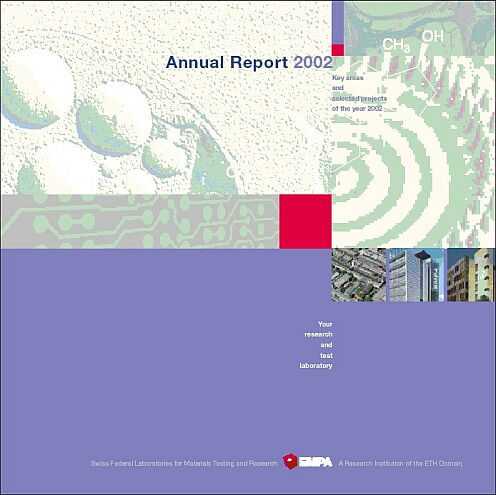Annual Report 2002
Scientific output increased
An increase in scientific output, more doctoral students, more external funding and an increase in income from services characterized the year 2002 at the EMPA. Significant steps have been taken towards achieving the high-priority aim of becoming a national center of competence for nanotechnology.

| At the end of 2002, EMPA employed 35 more scientific staff than in the previous year, although the budget remained the same as before. In particular, the number of doctoral students practically doubled. The percentage of female staff rose to 25.1% in 2002 from 24.4% the previous year, while women filled four upper-management positions. During the year covered by the report, 70 persons completed their practical training at the EMPA (previous year 49). In addition 19 (17) undergraduate students from the ETH Zurich, and various universities and technical schools were supervised. The number of apprentices fell slightly to 29 (from 31 in 2001). Total income for 2002 was 118.3 million Swiss francs, consisting of 81.5 million francs of federal government funding, services income of 16.1 million francs and external funding of 20.7 million francs. The latter figure includes payments from industry for application-oriented research, from institutions which promote research such as the Commission for Technology and Innovation (KTI) and Swiss National Funds, as well as European research programs. The number of refereed publications once again experienced an increase. From an average of 40 papers annually from 1990 to 2000, this figure rose to 67 in 2001 and again to 90 in 2002. The total publication count was 423 for the year. The EMPA Academy, EMPA’s platform for knowledge transfer, also demonstrated an upward trend in its third year of existence. The number of events offered increased, as did audience numbers – from about 4600 to over 6000 persons. On the other hand, the number of registered patents, license agreements and spin-offs went down over the period in question. However, large variations are characteristic of these particular data, and for a meaningful interpretation a longer time period must be analyzed. | ||
| New laboratories Visible signs of the «Nano» Center of Research Excellence are the foundation of a nanotechnology laboratory and the rapid expansion of EMPA infrastructure for research on the nanometer scale. The new laboratory at the Thun site, named «nanotech@surfaces» aims to concentrate on the following two areas of research:
Collaborative projects in this area with leading European research institutes such as the Max-Planck Institute for Polymer Research in Mainz, and the CSEM in Neuenburg, are already well established. A generally stronger emphasis on fundamental research with a long-term horizon will be achieved with the involvement of the Swiss National Centers of Competence in Research (NCCR). EMPA’s second new laboratory, «Functional polymers» will also engage in work on nanotechnology. The initial projects deal with the application of nanoparticles for integrating into polymer matrices and the targeted exploitation of nanoclusters for use in high-performance photographic paper. ----------------------- Editor: Robert Helmy, , Telefon: +41 1 823 45 92 | ||
| Here you can order the Annual Report 2002 or you can download it as a PDF-File (Size: 4.3 MB). Note: a more detailed scientific view of research programs and projects at EMPA is given in the report “EMPA Activities 2002”, published in English in April. Here you find a way to further Annual Reports und Activity Reports of earlier years. | ||
| ||||
